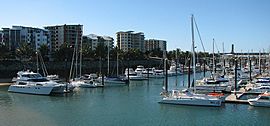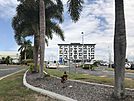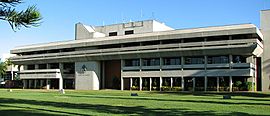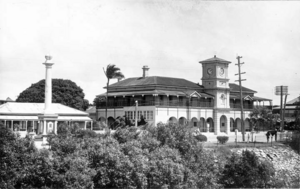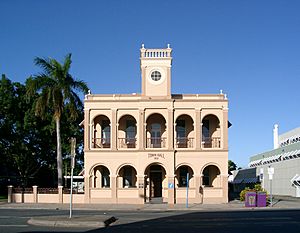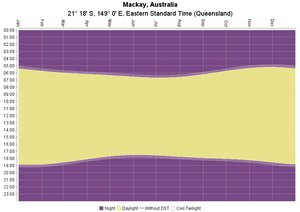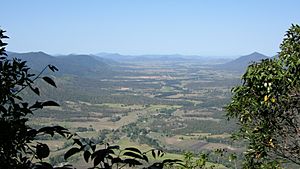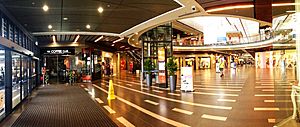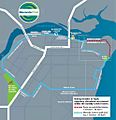Mackay, Queensland facts for kids
Quick facts for kids MackayQueensland |
|||||||||
|---|---|---|---|---|---|---|---|---|---|
|
From left to right; View of Mackay Marina
Historic City Bank, Art Deco architecture along Victoria Street Forgan Bridge over the Pioneer River, Mackay Airport Precinct Mackay City Council |
|||||||||
| Population | 80,148 (2018) | ||||||||
| • Density | 384.96/km2 (997.0/sq mi) | ||||||||
| Postcode(s) | 4740 | ||||||||
| Elevation | 11.0 m (36 ft) | ||||||||
| Area | 208.2 km2 (80.4 sq mi)(2011 urban) | ||||||||
| Time zone | AEST (UTC+10) | ||||||||
| Location |
|
||||||||
| LGA(s) | Mackay Region | ||||||||
| State electorate(s) |
|
||||||||
| Federal Division(s) | Dawson | ||||||||
|
|||||||||
Mackay is a city in the Mackay Region on the eastern or Coral Sea coast of Queensland, Australia. It is located about 970 kilometres (603 mi) north of Brisbane, on the Pioneer River. Mackay is described as being in either Central Queensland or North Queensland, as these regions are not precisely defined. More generally, the area is known as the Mackay–Whitsunday Region. Mackay is nicknamed the sugar capital of Australia because its region produces more than a third of Australia's sugar.
Contents
Name
The city was named after John Mackay. In 1860, he was the leader of an expedition into the Pioneer Valley. Initially Mackay proposed to name the river Mackay River after his father George Mackay. Thomas Henry Fitzgerald surveyed the township and proposed it was called Alexandra after Princess Alexandra of Denmark, who married Prince Edward (later King Edward VII). However, in 1862 the river was renamed to be the Pioneer River, after the HMS Pioneer in which Queensland Governor George Bowen travelled to the area, and the township name was changed to be Mackay in honour of John Mackay. Fitzgerald then decided to use the name Alexandra for his sugar cane plantation and sugar mill, which eventually provided the name to the Mackay suburb of Alexandra today.
There has always been much contention over the pronunciation of the name Mackay. Correspondence received by Mackay City Library in 2007, from descendants of John Mackay, confirms that the correct pronunciation is from the Gaelic name "MacAoidh" which is pronounced "ɑɪ" not "eɪ".
History
The area which is now Mackay City was originally inhabited by the local Yuibera people.
One of the first white settlers to travel through the Mackay region was Captain James Cook, who reached the Mackay coast on 1 June 1770 and named several local landmarks, including Cape Palmerston, Slade Point and Cape Hillsborough. It was during this trip that the Endeavour's botanist, Sir Joseph Banks, briefly recorded seeing Aborigines.
In 1860, John Mackay led an expedition to the Pioneer Valley and was the first European to visit the area now named after him.
In 1918, Mackay was hit by a major tropical cyclone causing severe damage and loss of life with hurricane-force winds and a large storm surge. The resulting death toll was further increased by an outbreak of bubonic plague.
The foundation stone of the Mackay War Memorial was laid on the river bank on 18 November 1928 by the mayor George Albert Milton. It was unveiled on 1 May 1929 by the mayor. Due to flooding, the memorial was relocated to Jubilee Park in 1945. Due to the construction of the Civic Centre, it was relocated to another part of the park in March 1973.
The largest loss of life in an Australian aircraft accident was a B17 aircraft, with 40 of 41 people on board perishing, on 14 June 1943, after departing from Mackay Aerodrome, and crashing in the Bakers Creek area.
On 18 February 1958, Mackay was hit with massive flooding caused by heavy rainfall upstream with 878 mm of rain falling at Finch Hatton in 24 hours. The flood peaked at 9.14 metres (29.99 ft). The water flowed down the valley and flooded Mackay within hours. Residents were rescued off rooftops by boats and taken to emergency accommodation. The flood broke Australian records.
On 15 February 2008, almost exactly 50 years from the last major flood, Mackay was devastated by severe flooding caused by over 600 mm of rain in 6 hours with around 2000 homes affected.

The Rats of Tobruk Memorial commemorates those who died at and since the Battle of Tobruk. The memorial was dedicated on 4 March 2001.
Mackay was battered by Tropical Cyclone Ului, a category three cyclone which crossed the coast at nearby Airlie Beach, around 1:30 am on Sunday 21 March 2010. Over 60,000 homes lost power and some phone services also failed during the storm, but no deaths were reported.
Heritage listings
Mackay has a number of heritage-listed sites, including:
- Alfred Street: Mackay Technical College
- Alfred Street: World War I Cenotaph
- 251 Alfred Street: Mackay Central State School
- Cemetery Road: Mackay General Cemetery
- Cowleys Road: Selwyn House, Mackay
- 38 East Gordon Street: East Gordon Street Sewerage Works
- 39 Gordon Street: Holy Trinity Church
- Habana Road: Richmond Mill Ruins
- 21 MacAlister Street: St Pauls Uniting Church
- 10 River Street: WH Paxton & Co buildings
- 31 River Street: Mackay Customs House
- 239 Nebo Road: Sugar Research Institute
- 63 Sydney Street: Mackay Town Hall
- Victoria Street: Mackay Court House and Police Station
- 63 Victoria Street: Commonwealth Bank Building
- 79 Victoria Street: Queensland National Bank
- 1 Wood Street: Pioneer Shire Council Building
- 57 Wood Street: Mackay Masonic Temple
Geography

Mackay is situated on the 21st parallel south on the banks of the Pioneer River. The Clarke Range lies to the west of the city. The city is expanding to accommodate for growth with most of the expansion happening in the Beachside, Southern, Central and Pioneer Valley suburbs.
Climate
Mackay has a humid subtropical climate (Cwa) under the Köppen climate classification. Average maximum temperatures range from 30 °C in summer to 23 °C in winter, while minimums range from 23 °C to 11 °C.
Winters are sunny and fairly dry, with minimum temperatures usually around 10 °C, but rarely any lower than 5 °C. Days are pleasant and warm; however, occasional cloudy days may keep the temperature below 20 °C all day. Frost is extremely rare in Mackay however may be recorded to the west of the city some winters. Mackay gets around 110.0 clear days annually.
Spring is usually dry, but significantly hotter and more humid than winter, with temperatures beginning to top 30 °C on a regular basis. Occasional thunderstorms may cause heavy downpours, but the very heavy rain will not arrive until later in summer.
December is the start of the wet season, which lasts until March or April. High humidity, almost daily rainfall and very warm nights are typical of this time of year. Monsoonal low pressure systems and tropical cyclones occasionally affect Mackay, and cause very heavy, prolonged periods of rain, with totals of up to 200 mm often being recorded in 24 hours during these systems.
Extreme temperatures in Mackay have ranged from 38.5 to −0.4 °C (101.3 to 31.3 °F). The highest rainfall ever recorded in 1 day was 627.4 mm (24.7 in) on 22 January 1918, which is among the heaviest 24-hour fall of any Australian city.
| Climate data for Mackay (Mackay Aero 1950–2013) | |||||||||||||
|---|---|---|---|---|---|---|---|---|---|---|---|---|---|
| Month | Jan | Feb | Mar | Apr | May | Jun | Jul | Aug | Sep | Oct | Nov | Dec | Year |
| Record high °C (°F) | 35.8 (96.4) |
37.3 (99.1) |
34.1 (93.4) |
32.9 (91.2) |
28.9 (84.0) |
32.0 (89.6) |
28.5 (83.3) |
32.1 (89.8) |
35.4 (95.7) |
38.5 (101.3) |
36.6 (97.9) |
38.2 (100.8) |
38.5 (101.3) |
| Average high °C (°F) | 30.1 (86.2) |
30.0 (86.0) |
29.2 (84.6) |
27.6 (81.7) |
25.1 (77.2) |
23.0 (73.4) |
22.5 (72.5) |
23.6 (74.5) |
25.7 (78.3) |
28.2 (82.8) |
29.4 (84.9) |
30.6 (87.1) |
27.1 (80.8) |
| Average low °C (°F) | 22.9 (73.2) |
23.2 (73.8) |
22.0 (71.6) |
19.3 (66.7) |
15.4 (59.7) |
12.6 (54.7) |
11.1 (52.0) |
11.9 (53.4) |
14.6 (58.3) |
18.2 (64.8) |
20.4 (68.7) |
22.2 (72.0) |
17.8 (64.0) |
| Record low °C (°F) | 16.5 (61.7) |
18.0 (64.4) |
14.2 (57.6) |
7.8 (46.0) |
3.8 (38.8) |
1.7 (35.1) |
−0.4 (31.3) |
2.0 (35.6) |
4.7 (40.5) |
9.5 (49.1) |
12.8 (55.0) |
15.6 (60.1) |
−0.4 (31.3) |
| Average rainfall mm (inches) | 317.1 (12.48) |
371.2 (14.61) |
240.0 (9.45) |
170.4 (6.71) |
92.2 (3.63) |
63.2 (2.49) |
35.7 (1.41) |
35.8 (1.41) |
26.7 (1.05) |
35.2 (1.39) |
81.1 (3.19) |
138.3 (5.44) |
1,606.9 (63.26) |
| Average rainy days (≥ 0.2mm) | 16.6 | 17.7 | 16.7 | 14.6 | 11.9 | 10.0 | 7.7 | 6.8 | 5.3 | 6.2 | 8.5 | 10.9 | 132.9 |
| Source: Bureau of Meteorology | |||||||||||||
Local attractions
The Bluewater Trail
The Bluewater Trail project, managed by the Mackay Regional Council, covers more than 20 kilometres (12 mi) of dedicated pedestrian paths and bikeways. Now completed the track links several new attractions and tourism infrastructure pieces around the city including the Bluewater Lagoon, the Bluewater Quay and the Mackay Regional Botanic Gardens. It also incorporates the Sandfly Creek walkway through East Mackay, and the Catherine Freeman Walk which connects West Mackay to the city under the Ron Camm Bridge.
Located in the south of Mackay, the Mackay Regional Botanic Gardens are the start of the Bluewater Trail. The gardens opened and replaced Queen's Park as Mackay's botanic gardens in 2003 containing an array of rare plants native to the Mackay area and Central Queensland. Before 2003, the area was commonly called The Lagoons, and is centred on the shores of a billabong that years ago formed part of the Pioneer River further to the north.
Heading east past the Mackay Base Hospital and along the Catherine Freeman Walk, the Bluewater Lagoon emerges. Comprising three tiered lagoons, the lagoon is a free family-friendly leisure facility overlooking the Pioneer River in the heart of Mackay's city centre. A waterfall connects the two main lagoon areas, which vary in depth up to 1.8 metres. Similar to the well-known Streets Beach at the South Bank Parklands in Brisbane, the lagoon is a popular summertime attraction for locals and visitors.
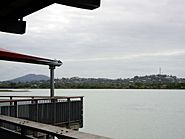
Further east along the trail is Bluewater Quay. As part of Queensland's 150th anniversary celebrations, $12 million has been invested into the transformation of River Street, to the immediate east of the Forgan Bridge. The street now has various public amenities including access to a new viewing platform, upgraded fishing jetty, stage areas, cafes and space for weekend markets. Being 250 metres long, the quay is built around the historic Leichhardt Tree (which falls under the Nauclea evergreen variety), a common meeting point for new migrants to Mackay who arrived at the old Port district along River Street.
Festival of Arts
The Mackay region is home to the Mackay Festival of Arts held annually throughout July. Now more than 20 years old, it is the largest regional arts festival in Queensland. The festival features wine and cheese tasting sessions, live jazz and other music, stand-up routines, art exhibitions, dance and other performances.
The City Centre
The City Centre is noted for its art-deco inspired architecture, with many buildings throughout the main streets of the central business district featuring distinctive designs from the early 20th century. The precinct was upgraded in the 1990s through a unique community arts project. The overall theme depicts the environmental beauty of the Mackay region and consists of bronzed plaques, sculptures and terrazzo/mosaic tiles. Of particular interest is a sculptured free-form seat in the shape of a bommie, or bombora, and covered in myriad colours depicting the Great Barrier Reef through to the rainforests of Eungella National Park. Many boutique stores, restaurants, bars and nightclubs are established throughout the precinct.
Mackay Marina Village
Mackay Marina Village is a coastal precinct located adjacent to the Mackay Harbour. The marina itself has nearly 500 berths. It is also home to a sizeable residential village of luxury apartments, in addition to the Clarion Mackay Marina luxury hotel.
Gateway to the Pioneer Valley
The scenic Pioneer Valley spreads out to the west of Mackay, with the Pioneer River meandering through it 120 kilometres (75 mi) to the mouth at the port of Mackay. Nearly all of the sugar cane grown in the Mackay region comes from the Pioneer Valley, and it is synonymous with the rich soils and irrigation with which the sugar industry in Mackay has thrived over the past century.
Perhaps most notable are the natural assets of the Pioneer Valley. These include the walking tracks and swimming holes of Finch Hatton Gorge. The Eungella National Park, located at the very top of the range, is the longest and oldest stretch of subtropical rainforest in Australia, covering more than 51,700 hectares. It is one of the few places where platypus can be seen swimming in the wild, while more than 225 species of bird have been recorded in the surrounding forests.
Islands and beaches
Mackay has 31 beaches within driving distance. Closest to the city are Illawong, Far and Town beaches. The patrolled Harbour Beach, adjacent to the Mackay Marina, is the most popular, being suitable for swimming. Lambert's Beach is also close to the city. Further north of the city are popular beaches at Bucasia, Dolphin Heads, Blacks Beach, Shoal Point and Eimeo – collectively these areas are known as the Northern Beaches. The Northern Beaches are popular with visitors, but are increasingly being developed as residential areas for Mackay's growing population.
The islands immediately off Mackay are renowned for their azure blue waters, and are popular with fishermen. St Bees Island in particular is a well- known fishing spot. Brampton Island, to the north-east of the city, is a resort destination, with body therapy, water sports and snorkelling on offer. Flights to Brampton are available from Mackay Airport, as are boats from the marina. Carlisle, Scawfell and Keswick are other notable islands. Each is a national park surrounded by coral reefs. During the peak season from June to the end of August, whales can be heard and seen around these islands.
River Sessions Festival
Held annually in June, River Sessions is Mackay and Central Queensland's premier youth and contemporary music festival. The festival features the best rock, hip-hop, alternative, folk, pop and dance music acts from around Australia.
Transport
Two major highways, the A1 (Bruce Highway), and State Route 70 (Peak Downs Highway), pass through Mackay. The A1 connects the city to Townsville, Proserpine and Cairns in the north, and Rockhampton and Brisbane in the south. The Peak Downs Highway connects it to Moranbah, Clermont and Emerald in the south-west. In September 2020 the city was fully bypassed with users of the Bruce Highway able to use the new Mackay Ring Road to avoid the city.
The North Coast railway line meets the western line in the city's south. Trains from Brisbane pass through Mackay railway station and continue through to Proserpine, Townsville and Cairns, including the regular Spirit of Queensland service between Brisbane and Cairns. Minerals from the western line (Moranbah and other coal mining centres) are transported to Hay Point and Dalrymple Bay Coal Terminals for trans-shipment to other destinations. Mackay Harbour deals mainly with sugar exports and visiting cruise ships.
The city is served by Mackay Airport, from which QantasLink, Virgin Australia, and Jetstar offer flights to Brisbane, Sydney and Melbourne, as well as to regional destinations such as Geelong, Cairns, Townsville, Rockhampton and Gladstone. MacAir Airlines previously provided a limited service into and out of Mackay for mining companies before it went into receivership in 2009.
Mackay Transit Coaches operates from North Mackay to South Mackay. The area with the best service coverage is Mackay's central business district.
In popular culture
Mackay is mentioned in "Gladstone Pier", the song by Redgum from the 1984 album Frontline.
Sister cities
Mackay has the following sister cities:
 Kailua Kona, Hawaii, United States since 4 January 1966
Kailua Kona, Hawaii, United States since 4 January 1966 Matsuura, Japan since 22 July 1989
Matsuura, Japan since 22 July 1989 Honiara, Solomon Islands since 5 July 1995
Honiara, Solomon Islands since 5 July 1995 Yantai, China since 15 November 2012
Yantai, China since 15 November 2012
Economy
As of the 2007–08, Mackay contributed $15.4 billion to the Australian economy, or 7.1% of Queensland's gross state product (GSP). This is largely on the back of its export-oriented industries of sugar and mining.
Mackay is famous for its history as one of Australia's largest sugarcane farming regions. However, in recent years, the mining industry has become the mainstay of the local economy.
Mining
Mackay is widely recognised as the gateway to the Bowen Basin coal mining reserves of Central Queensland. It is the single largest coal reserve in Australia, with 34 operational coal mines extracting more than 100 million tonnes annually. While much of this is used in Australia, Japan and China are the largest export recipients.
Sugar
Mackay was known as the "sugar capital" of Australia, producing a sizeable portion of Australia's domestic supplies and exports. However, the industry experienced a decline in the 2000s.
The industry in Mackay has its roots back in the 19th century. Historically, plantations were small and had their own mills to crush the cane during harvest. Over the years as the industry grew and developed, co-operatives were formed to consolidate the harvesting, crushing and distribution of the sugar in selected zones. Throughout the 20th century, the privately owned mills in the Mackay district closed one by one until only three remained – Marian, Racecourse Mill, and Farleigh. Today, Pleystowe is the oldest surviving mill in the district (but closed in 2008).
The Marian Sugar Cane Mill is situated in Marian, 25 km west of Mackay. At the Farleigh Mill, there are mill tours accessed via the internet. Racecourse Mill also does tours, and therefore accessible via the internet. Mackay Sugar operates three of these remaining mills, including Racecourse, which became site of the region's first sugar refinery (which is owned by CSR Limited) in the 1990s. Growers in the region have a total cane production area of approximately 86,000 hectares. The growers are capable (in good seasons) of supplying up to 6.5 million tonnes of cane to the factories for processing. On average, Mackay Sugar produces about 850,000 tonnes of raw sugar and 180,000 tonnes of the by-product molasses annually.
The sugar industry in Mackay has faced steep challenges since 2000, since it is largely dependent on high world sugar prices to remain viable. However, efforts are going into diversifying the use of sugar cane for different purposes. These include a planned energy co-generation plant that could deliver up to 30 per cent of Mackay's annual electricity supply.
Tourism
Compared to many of its neighbouring cities and regions in Queensland, Mackay's tourism industry is small and still developing. This is despite being close to notable attractions including Eungella National Park, the Great Barrier Reef, and the Whitsunday Islands.
Latest figures indicate about 685,000 domestic and international visitors come to the region annually. More telling, however, is that domestic and international visitor night stays have increased to 2.7 million annually, an increase of nearly 1 million since 2000.
Several new hotels have opened in the region since 2000, further indication of a growing industry. These include The Clarion International, Quest Serviced Apartments and the Ibis Mackay Airport.
Marine
Like tourism, the marine industry in Mackay is small but has a lot of potential. Mackay is well situated to become a major service centre for the marine industry, being in immediate proximity to the Whitsundays, and located halfway between Brisbane and Cairns.
Currently the Mackay Marina is the largest base in the district for the maintenance, refit and related services for all marine craft, particularly Super Yachts. The Mackay Whitsunday Super Yacht Cluster, a group of regional companies focusing on providing integrated repair, refit and provisioning for the increasing number of visiting super yachts, was established in 2001 to support and promote the development of this sector.
Retail
Mackay has three main shopping centres. Caneland Central is the largest of these, with more than 130 speciality stores. Myer is among the new anchor tenants. This expansion was opened on 13 October 2011.
Mount Pleasant Shopping Centre is the second major shopping centre in the Mackay region. It hosts department stores, supermarkets and other speciality outlets. Outside the main centre, a number of bulky-good outlets also operate, along with a six-screen Birch Carroll and Coyle cinema complex.
The Mackay City Heart, located in the older city centre, is also another thriving part of the city. It is the home of many of the region's banks, law, accounting and other professional service firms.
Sport
Rugby league is the most popular sport in Mackay, Mackay Cutters rugby league team played their first season in 2008 in the Queensland Cup and act as a feeder team to the North Queensland Cowboys (NRL). The 2nd placed Canterbury-Bankstown Bulldogs hosted a 'home' game at Mackay against the ladder leading Melbourne Storm in Round 16 of the 2012 NRL season for a record Mackay sporting ground attendance. In soccer, Magpies Crusaders United represents the Mackay region in the National Premier Leagues Queensland (NPLQ). In Basketball, Mackay Meteorettes (women) and Mackay Meteors (men) represent the region in the NBL1 North. Mackay also has a local Australian rules football league AFL Mackay and premiership AFLW matches are played at the Great Barrier Reef Arena.
Mackay also has a local roller derby league: Mackay City Roller Maidens. The Mackay Cricket Association organises competition among its 6 member clubs: Magpies, Pioneer Valley, Brothers Mackay, Northern Suburbs, Southern Suburbs, and Walkerston. In the 1920s the Olympic Theatre in Mackay was a popular venue for professional boxing and saw stars like Colin Bell and Tom Heeney fight there. Such teams in junior and senior are: Mackay City Hawks, Northern Beaches Magpies, Moranbah Bulldogs, Eastern Swans, Sarina Demons and Mackay Saints.
Images for kids
See also
 In Spanish: Mackay (Queensland) para niños
In Spanish: Mackay (Queensland) para niños


